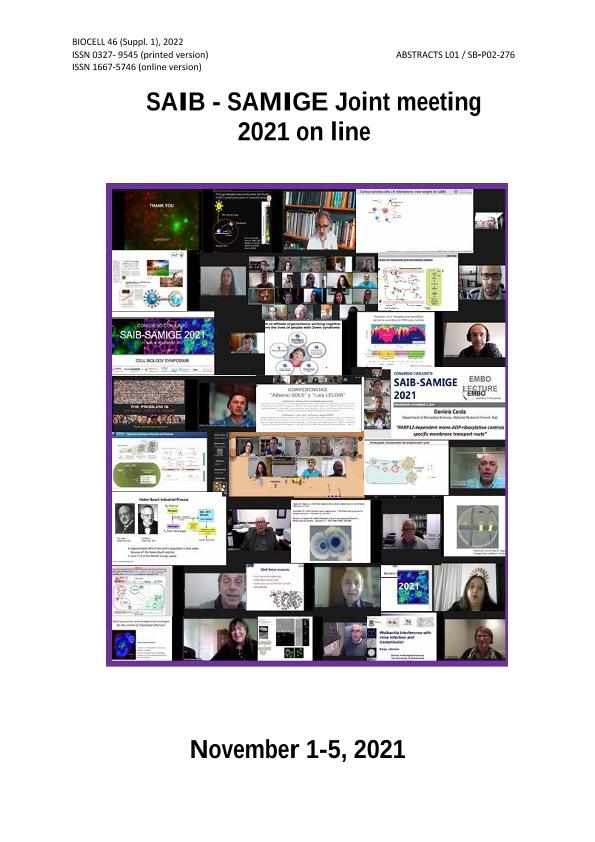Mostrar el registro sencillo del ítem
dc.contributor.author
Balmaceda, Rocio Soledad

dc.contributor.author
Ramos Ricciutti, Fernando E.
dc.contributor.author
Studdert, Claudia Alicia

dc.contributor.author
Herrera Seitz, Karina

dc.date.available
2023-11-06T13:37:59Z
dc.date.issued
2021
dc.identifier.citation
Chemotaxis and Wsp-like pathways affect biofilm formation in Halomonas titanicae KHS3; Congreso Conjunto SAIB-SAIGE 2021: LVII Reunión Anual de la Sociedad Argentina de Investigaciones en Bioquímica y Biología Molecular (SAIB). XVI Congreso Anual de la Asociación Civil de Microbiología General (SAMIGE); Argentina; 2021; 156-156
dc.identifier.issn
0327-9545
dc.identifier.uri
http://hdl.handle.net/11336/217108
dc.description.abstract
Halomonas titanicae KHS3 is a moderately halophilic bacteria isolated from seawater of Mar del Plata harbour. During the analysis of its genomic sequence, two chemosensory clusters were identified. Cluster 1 includes genes and organization similar to those of the canonical Escherichia coli chemotaxis gene cluster and is involved in Halomonas chemotaxis. Cluster 2 encodes a Wsp-like pathway, whose genes and organization resemble those of the homonymous Pseudomonas aeruginosa cluster. In this pathway, a chemoreceptor-controlled histidine kinase activates a diguanylate cyclase (DGC) by phosphorylation, and the downstream response includes higher levels of biofilm. In this work, the participation of both chemosensory pathways in motility and biofilm formation was analyzed. Cluster 1 function was disrupted by a deletion in its histidine kinase gene, cheA1 (che1- mutant). The wsp-like pathway was targeted in two different ways. On one hand, Htc10 (cluster 2 chemoreceptor) was inactivated by a plasmid insertion (che2- mutant). On the other, the methylesterase gene cheB2 was deleted in order to assess the effect of an overmethylation (and presumably over-activation) of the pathway on the phenotype (che2++ mutant). Both che1- and che2++ mutants showed a significantly exacerbated biofilm formation when compared to wild-type strain when using the crystal violet assay. However, only the che2++ cells had a wrinkly aspect in agar medium, suggesting that the increased ability to form biofilm of the two strains was due to different mechanisms. Chemotaxis behavior, as assessed in soft agar plates, was severely affected in both hyperbiofilm mutants. However, when compared by video tracking analysis using SMT software, the motility of che1- mutant was indistinguishable from the wild-type strain, whereas che2++ showed a remarkable decrease in the number of motile cells. Substrate adherence after a short centrifugation was significantly increased in che2++ cells, and long-term biofilm assays also showed increased persistence of adhered cells in this mutant strain. Likewise, Congo Red staining of macrocolonies revealed an increased production of exopolysaccharides in this strain. All these features are consistent with a role of cluster 2 in biofilm formation as described for the Pseudomonas wsp pathway. Consistently, the che2-mutant showed a reduced ability to form biofilm under the same circumstances. The hyperbiofilm phenotype of the che1- mutant remains intriguing: complementation with very low levels of CheA1 restores the wild-type biofilm behavior even though chemotaxis is not fully restored. Up to now, we cannot find the mechanism underlying the increased biofilm in the absence of the chemotaxis kinase. Disruption of the cluster 2 chemoreceptor gene in the che1- mutant will help to elucidate whether or not the hyperbiofilm phenotype is dependent on the presence of cluster 2.
dc.format
application/pdf
dc.language.iso
spa
dc.publisher
Tech Science Press

dc.rights
info:eu-repo/semantics/openAccess
dc.rights.uri
https://creativecommons.org/licenses/by-nc-sa/2.5/ar/
dc.subject
HALOMONAS
dc.subject
QUIMIOTAXIS
dc.subject
WSP-LIKE
dc.subject
BIOFILM
dc.subject.classification
Biología Celular, Microbiología

dc.subject.classification
Ciencias Biológicas

dc.subject.classification
CIENCIAS NATURALES Y EXACTAS

dc.title
Chemotaxis and Wsp-like pathways affect biofilm formation in Halomonas titanicae KHS3
dc.type
info:eu-repo/semantics/publishedVersion
dc.type
info:eu-repo/semantics/conferenceObject
dc.type
info:ar-repo/semantics/documento de conferencia
dc.date.updated
2022-11-09T17:28:19Z
dc.identifier.eissn
1667-5746
dc.journal.volume
46
dc.journal.number
1
dc.journal.pagination
156-156
dc.journal.pais
Estados Unidos

dc.journal.ciudad
Henderson
dc.description.fil
Fil: Balmaceda, Rocio Soledad. Consejo Nacional de Investigaciones Científicas y Técnicas. Centro Científico Tecnológico Conicet - Santa Fe. Instituto de Agrobiotecnología del Litoral. Universidad Nacional del Litoral. Instituto de Agrobiotecnología del Litoral; Argentina
dc.description.fil
Fil: Ramos Ricciutti, Fernando E.. Consejo Nacional de Investigaciones Científicas y Técnicas. Centro Científico Tecnológico Conicet - Santa Fe. Instituto de Agrobiotecnología del Litoral. Universidad Nacional del Litoral. Instituto de Agrobiotecnología del Litoral; Argentina
dc.description.fil
Fil: Studdert, Claudia Alicia. Consejo Nacional de Investigaciones Científicas y Técnicas. Centro Científico Tecnológico Conicet - Santa Fe. Instituto de Agrobiotecnología del Litoral. Universidad Nacional del Litoral. Instituto de Agrobiotecnología del Litoral; Argentina
dc.description.fil
Fil: Herrera Seitz, Karina. Consejo Nacional de Investigaciones Científicas y Técnicas. Centro Científico Tecnológico Conicet - Mar del Plata. Instituto de Investigaciones Biológicas. Universidad Nacional de Mar del Plata. Facultad de Ciencias Exactas y Naturales. Instituto de Investigaciones Biológicas; Argentina
dc.relation.alternativeid
info:eu-repo/semantics/altIdentifier/url/https://www.saib.org.ar/sites/default/files/TSP_BIOCELL_46213-SAIB-SAMIGE%202021.pdf
dc.conicet.rol
Autor

dc.conicet.rol
Autor

dc.conicet.rol
Autor

dc.conicet.rol
Autor

dc.coverage
Nacional
dc.type.subtype
Congreso
dc.description.nombreEvento
Congreso Conjunto SAIB-SAIGE 2021: LVII Reunión Anual de la Sociedad Argentina de Investigaciones en Bioquímica y Biología Molecular (SAIB). XVI Congreso Anual de la Asociación Civil de Microbiología General (SAMIGE)
dc.date.evento
2021-11-01
dc.description.paisEvento
Argentina

dc.type.publicacion
Journal
dc.description.institucionOrganizadora
Sociedad Argentina de Investigaciones en Bioquímica y Biología Molecular
dc.description.institucionOrganizadora
Asociación Civil de Microbiología General
dc.source.revista
Biocell

dc.date.eventoHasta
2021-11-05
dc.type
Congreso
Archivos asociados
